Check out these things, it might help you:
DirectX uses left hadned coordinate systems. I think you will get a right handed coordinate system from Maya/3ds Max when you export to .obj files
://msdn.microsoft.com/en-us/library/windows/desktop/bb204853(v=vs.85).aspx
Compare your vertecies count, in Maya and then in your program.
Figure out the reason why you get 1.000671 in your TU/TV coordinates, this looks like it is a bit high.
Make sure you export as Triangles and not Rectangles.
Show your normals in Maya, it looks like some part of the ground/rectangle this object is standing on is missing. Or you could try to disable culling in your D3D11_RASTERIZER_DESC.
I don't have Maya installed on my computer right now, but i think you can get a graphical view in there that shows you the excact TU/TV coordinates on your texture.
http ://www.youtube.com/watch?v=T-fFpmBYP_Q That view is displayed in this video at 4,21.
EDIT:
Providing some code examples:
struct D3D11TextureVertexType
{
XMFLOAT3 Position;
XMFLOAT2 TX;
};
This is how you could put the vertices on the pipe:
hr = m_pd3dImmediateContext->Map(MyID3D11Buffer, 0, D3D11_MAP_WRITE_DISCARD, 0, &mappedResource);
if (FAILED(hr)) return hr;
pData = (D3D11TextureVertexType*)mappedResource.pData;
memcpy(pData, MYOBJECTVERTICES/*this is D3D11TextureVertexType*/, sizeof(D3D11TextureVertexType) * VertexCount);
m_pd3dImmediateContext->Unmap(MyID3D11Buffer, 0);
stride = sizeof(D3D11TextureVertexType);
offset = 0;
m_pd3dImmediateContext->IASetVertexBuffers(0, 1, &MyID3D11Buffer, &stride, &offset);
m_pd3dImmediateContext->IASetIndexBuffer(m_AdjRectangleIBuffer, DXGI_FORMAT_R32_UINT, 0);
m_pd3dImmediateContext->IASetPrimitiveTopology(D3D11_PRIMITIVE_TOPOLOGY_TRIANGLELIST);
result = m_TextureShader->Render(m_pd3dImmediateContext, 6, worldMatrix, viewMatrix, orthoMatrix, m_Textures[Q.textureID]->pSRV); if (!result)
{
return S_FALSE;
}
This is some intresting functions in the TextureShaderClass
bool Render(ID3D11DeviceContext* deviceContext, int indexCount, DirectX::CXMMATRIX worldMatrix, DirectX::CXMMATRIX viewMatrix, DirectX::CXMMATRIX projectionMatrix, ID3D11ShaderResourceView* texture)
{
bool result;
result = SetShaderParameters(deviceContext, worldMatrix, viewMatrix, projectionMatrix, texture);
if (!result)
{
return false;
}
RenderShader(deviceContext, indexCount);
return true;
}
bool InitializeShader(ID3D11Device* device, const WCHAR* filename)
{
HRESULT result;
ID3D10Blob* errorMessage;
ID3D10Blob* vertexShaderBuffer;
ID3D10Blob* pixelShaderBuffer;
D3D11_INPUT_ELEMENT_DESC polygonLayout[2];
unsigned int numElements;
D3D11_BUFFER_DESC matrixBufferDesc;
D3D11_SAMPLER_DESC samplerDesc;
errorMessage = 0;
vertexShaderBuffer = 0;
pixelShaderBuffer = 0;
result = D3DCompileFromFile(filename, NULL, NULL, "TextureVertexShader", "vs_5_0", 0, 0, &vertexShaderBuffer, &errorMessage);
if (FAILED(result))
{
if (errorMessage)
{
//OutputShaderErrorMessage(errorMessage, hwnd, filename);
}
else
{
MessageBox(0, filename, L"Missing Shader File", MB_OK);
}
return false;
}
result = D3DCompileFromFile(filename, NULL, NULL, "TexturePixelShader", "ps_5_0", 0, 0, &pixelShaderBuffer, &errorMessage);
if (FAILED(result))
{
if (errorMessage)
{
//OutputShaderErrorMessage(errorMessage, hwnd, psFilename);
}
else
{
MessageBox(0, filename, L"Missing Shader File", MB_OK);
}
return false;
}
result = device->CreateVertexShader(vertexShaderBuffer->GetBufferPointer(), vertexShaderBuffer->GetBufferSize(), NULL, &m_vertexShader);
if (FAILED(result))
{
return false;
}
result = device->CreatePixelShader(pixelShaderBuffer->GetBufferPointer(), pixelShaderBuffer->GetBufferSize(), NULL, &m_pixelShader);
if (FAILED(result))
{
return false;
}
polygonLayout[0].SemanticName = "POSITION";
polygonLayout[0].SemanticIndex = 0;
polygonLayout[0].Format = DXGI_FORMAT_R32G32B32_FLOAT;
polygonLayout[0].InputSlot = 0;
polygonLayout[0].AlignedByteOffset = 0;
polygonLayout[0].InputSlotClass = D3D11_INPUT_PER_VERTEX_DATA;
polygonLayout[0].InstanceDataStepRate = 0;
polygonLayout[1].SemanticName = "TEXCOORD";
polygonLayout[1].SemanticIndex = 0;
polygonLayout[1].Format = DXGI_FORMAT_R32G32_FLOAT;
polygonLayout[1].InputSlot = 0;
polygonLayout[1].AlignedByteOffset = D3D11_APPEND_ALIGNED_ELEMENT;
polygonLayout[1].InputSlotClass = D3D11_INPUT_PER_VERTEX_DATA;
polygonLayout[1].InstanceDataStepRate = 0;
numElements = sizeof(polygonLayout) / sizeof(polygonLayout[0]);
result = device->CreateInputLayout(polygonLayout, numElements, vertexShaderBuffer->GetBufferPointer(), vertexShaderBuffer->GetBufferSize(), &m_layout);
if (FAILED(result))
{
return false;
}
vertexShaderBuffer->Release();
vertexShaderBuffer = 0;
pixelShaderBuffer->Release();
pixelShaderBuffer = 0;
matrixBufferDesc.Usage = D3D11_USAGE_DYNAMIC;
matrixBufferDesc.ByteWidth = sizeof(MatrixBufferType);
matrixBufferDesc.BindFlags = D3D11_BIND_CONSTANT_BUFFER;
matrixBufferDesc.CPUAccessFlags = D3D11_CPU_ACCESS_WRITE;
matrixBufferDesc.MiscFlags = 0;
matrixBufferDesc.StructureByteStride = 0;
result = device->CreateBuffer(&matrixBufferDesc, NULL, &m_matrixBuffer);
if (FAILED(result))
{
return false;
}
samplerDesc.Filter = D3D11_FILTER_MIN_MAG_MIP_LINEAR;
samplerDesc.AddressU = D3D11_TEXTURE_ADDRESS_WRAP;
samplerDesc.AddressV = D3D11_TEXTURE_ADDRESS_WRAP;
samplerDesc.AddressW = D3D11_TEXTURE_ADDRESS_WRAP;
samplerDesc.MipLODBias = 0.0f;
samplerDesc.MaxAnisotropy = 1;
samplerDesc.ComparisonFunc = D3D11_COMPARISON_ALWAYS;
samplerDesc.BorderColor[0] = 0;
samplerDesc.BorderColor[1] = 0;
samplerDesc.BorderColor[2] = 0;
samplerDesc.BorderColor[3] = 0;
samplerDesc.MinLOD = 0;
samplerDesc.MaxLOD = D3D11_FLOAT32_MAX;
result = device->CreateSamplerState(&samplerDesc, &m_sampleState);
if (FAILED(result))
{
return false;
}
return true;
}
bool SetShaderParameters(ID3D11DeviceContext* deviceContext, DirectX::CXMMATRIX worldMatrix, DirectX::CXMMATRIX viewMatrix, DirectX::CXMMATRIX projectionMatrix, ID3D11ShaderResourceView* texture)
{
HRESULT result;
D3D11_MAPPED_SUBRESOURCE mappedResource;
MatrixBufferType* dataPtr;
unsigned int bufferNumber;
result = deviceContext->Map(m_matrixBuffer, 0, D3D11_MAP_WRITE_DISCARD, 0, &mappedResource);
if (FAILED(result))
{
return false;
}
dataPtr = (MatrixBufferType*)mappedResource.pData;
DirectX::XMMATRIX world = worldMatrix;
world = XMMatrixTranspose(world);
DirectX::XMMATRIX view = viewMatrix;
view = XMMatrixTranspose(view);
DirectX::XMMATRIX projection = projectionMatrix;
projection = XMMatrixTranspose(projection);
dataPtr->world = world;
dataPtr->view = view;
dataPtr->projection = projection;
deviceContext->Unmap(m_matrixBuffer, 0);
bufferNumber = 0;
deviceContext->VSSetConstantBuffers(bufferNumber, 1, &m_matrixBuffer);
deviceContext->PSSetShaderResources(0, 1, &texture);
return true;
}
void RenderShader(ID3D11DeviceContext* deviceContext, int indexCount)
{
deviceContext->IASetInputLayout(m_layout);
deviceContext->VSSetShader(m_vertexShader, NULL, 0);
deviceContext->PSSetShader(m_pixelShader, NULL, 0);
deviceContext->PSSetSamplers(0, 1, &m_sampleState);
deviceContext->DrawIndexed(indexCount, 0, 0);
return;
}



 Would this be the issue? or should I reconstruct texture coords as brushed on at http://www.gamedev.net/topic/600234-texcoord-count-is-different-than-vertex-count/
Would this be the issue? or should I reconstruct texture coords as brushed on at http://www.gamedev.net/topic/600234-texcoord-count-is-different-than-vertex-count/ 